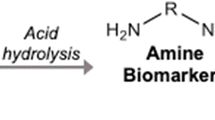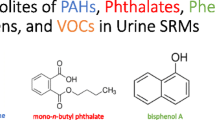Summary
Epidemiological evidence that occupational exposure to o-toluidine and aniline is associated with an increased risk of bladder cancer led to efforts to identify biomarkers of workplace exposures to these aromatic amines. For the determination of o-toluidine and aniline in worker urine specimens, a method using high performance liquid chromatography (HPLC) followed by electrochemical detection was developed. The limits of detection were 0.6 μg/l and 1.4 μg/l for o-toluidine and aniline, respectively. Recovery of o-toluidine and aniline from spiked urine averaged 86% and 93%, respectively, over a range of 4-100 μg/l. Reproducibility in the range 2-100 μg/l for analyses of split field samples was 13% (average RSD) for o-toluidine and 16% (average RSD) for aniline. Application of this method to pre- and post-shift samples collected from potentially exposed and unexposed workers indicated elevated concentrations of o-toluidine and aniline in urine from exposed workers. To develop methods for biomarkers of internal dose, o-toluidine binding to the blood proteins hemoglobin and albumin was investigated utilizing in-vivo (rodent) and in-vitro (hemoglobin and albumin) studies. Base-hydrolyzable protein adducts were analyzed by HPLC (fluorescence) and/or GC/electron capture (EC). The methods were compared for sample preparation requirements, selectivity and sensitivity. While the GC/EC method was more sensitive than HPLC, the presence of interfering peaks limited the utility of this approach. Results from these studies suggested that the HPLC method could be useful for determination of o-toluidine exposures in individuals acutely or chronically exposed to high levels.
Similar content being viewed by others
References
American Conference of Governmental Industrial Hygienists (1986) Aniline. Documentation of the Threshold Limit Values and Biological Exposure Indices. Cincinnati: ACGIH, BEI51-BEI53
Cheever KL, Richards DE, Plotnick HB (1980) Metabolism of ortho-, meta-, and para-toluidine in the adult male rat. Toxicol Appl Pharmacol 56:361–369
Cheever KL, DeBord DG, Swearengin TF, Booth-Jones AD (1992) Ortho-toluidine blood protein adducts: HPLC analysis with fluorescence detection after a single dose in the adult male rat. Fundam Appl Toxicol 18:522–531
El-Bayoumy K, Donahue JM, Hecht SS, Hoffmann D (1986) Identification and quantitative determination of aniline and toluidines in human urine. Cancer Res 46:6064–6067
Koch, DD, Miller, RC (1992) “Half-life” is erroneously used to describe the disappearance of erythrocytes and hemoglobin from the circulation. Clin Chem 38:1389
Lewalter J, Korallus U (1985) Blood protein conjugates and acetylation of aromatic amines. New findings on biological monitoring. Int Arch Occup Environ Health 56:179–196
National Institute for Occupational Safety and Health (1989) Interim Report No. 1, HETA 88-159, Goodyear Tire and Rubber Company, Niagara Falls, NY, Cincinnati
Son OS, Everett DW, Fiala ES (1980) Metabolism of o-[methyl-14C]toluidine in the F344 rat. Xenobiotica 10:457–468
Stillwell WG, Bryant MS, Wishnok JS (1987) GC/MS analysis of biologically important aromatic amines. Application to human dosimetry. Biomed Environ Mass Spectrom 14:221–227
Ward E, Carpenter A, Markowitz S, Roberts D, Halperin W (1991) Excess number of bladder cancers in workers exposed to ortho-toluidine and aniline. J Natl Cancer Inst 83:501–506
Author information
Authors and Affiliations
Rights and permissions
About this article
Cite this article
Teass, A.W., DeBord, D.G., Browns, K.K. et al. Biological monitoring for occupational exposures to o-toluidine and aniline. Int. Arch Occup Environ Heath 65 (Suppl 1), S115–S118 (1993). https://doi.org/10.1007/BF00381320
Issue Date:
DOI: https://doi.org/10.1007/BF00381320




